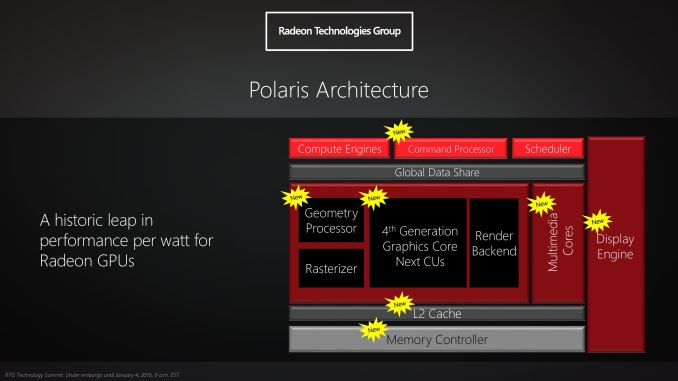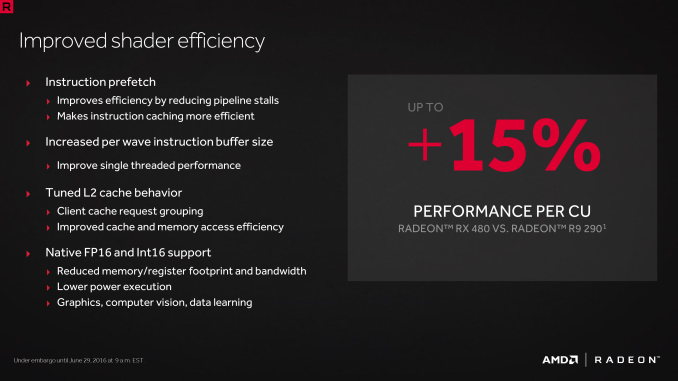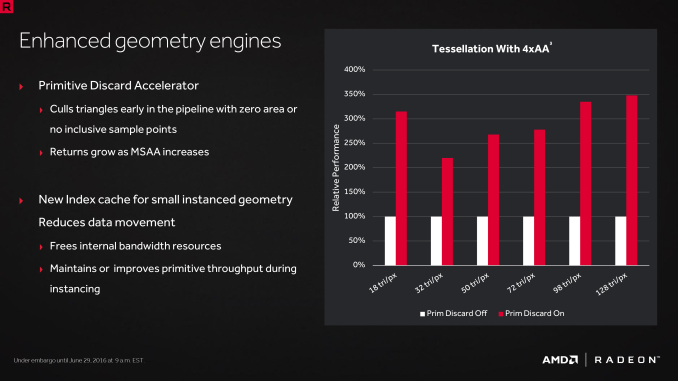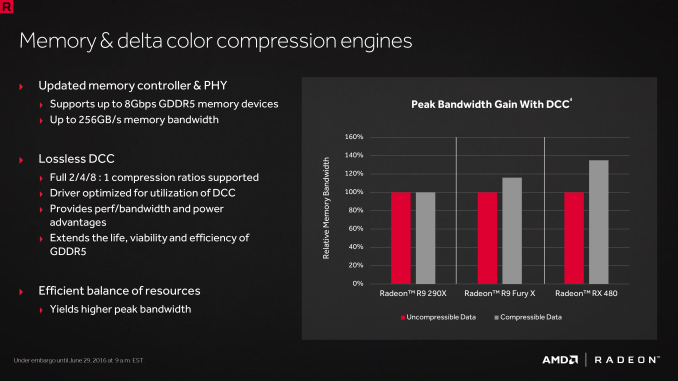The AMD Radeon RX 480 Preview: Polaris Makes Its Mainstream Mark
by Ryan Smith on June 29, 2016 9:00 AM ESTThe Polaris Architecture: In Brief
For today’s preview I’m going to quickly hit the highlights of the Polaris architecture.
In their announcement of the architecture this year, AMD laid out a basic overview of what components of the GPU would see major updates with Polaris. Polaris is not a complete overhaul of past AMD designs, but AMD has combined targeted performance upgrades with a chip-wide energy efficiency upgrade. As a result Polaris is a mix of old and new, and a lot more efficient in the process.
At its heart, Polaris is based on AMD’s 4th generation Graphics Core Next architecture (GCN 4). GCN 4 is not significantly different than GCN 1.2 (Tonga/Fiji), and in fact GCN 4’s ISA is identical to that of GCN 1.2’s. So everything we see here today comes not from broad, architectural changes, but from low-level microarchitectural changes that improve how instructions execute under the hood.
Overall AMD is claiming that GCN 4 (via RX 480) offers a 15% improvement in shader efficiency over GCN 1.1 (R9 290). This comes from two changes; instruction prefetching and a larger instruction buffer. In the case of the former, GCN 4 can, with the driver’s assistance, attempt to pre-fetch future instructions, something GCN 1.x could not do. When done correctly, this reduces/eliminates the need for a wave to stall to wait on an instruction fetch, keeping the CU fed and active more often. Meanwhile the per-wave instruction buffer (which is separate from the register file) has been increased from 12 DWORDs to 16 DWORDs, allowing more instructions to be buffered and, according to AMD, improving single-threaded performance.
Outside of the shader cores themselves, AMD has also made enhancements to the graphics front-end for Polaris. AMD’s latest architecture integrates what AMD calls a Primative Discard Accelerator. True to its name, the job of the discard accelerator is to remove (cull) triangles that are too small to be used, and to do so early enough in the rendering pipeline that the rest of the GPU is spared from having to deal with these unnecessary triangles. Degenerate triangles are culled before they even hit the vertex shader, while small triangles culled a bit later, after the vertex shader but before they hit the rasterizer. There’s no visual quality impact to this (only triangles that can’t be seen/rendered are culled), and as claimed by AMD, the benefits of the discard accelerator increase with MSAA levels, as MSAA otherwise exacerbates the small triangle problem.
Along these lines, Polaris also implements a new index cache, again meant to improve geometry performance. The index cache is designed specifically to accelerate geometry instancing performance, allowing small instanced geometry to stay close by in the cache, avoiding the power and bandwidth costs of shuffling this data around to other caches and VRAM.
Finally, at the back-end of the GPU, the ROP/L2/Memory controller partitions have also received their own updates. Chief among these is that Polaris implements the next generation of AMD’s delta color compression technology, which uses pattern matching to reduce the size and resulting memory bandwidth needs of frame buffers and render targets. As a result of this compression, color compression results in a de facto increase in available memory bandwidth and decrease in power consumption, at least so long as buffer is compressible. With Polaris, AMD supports a larger pattern library to better compress more buffers more often, improving on GCN 1.2 color compression by around 17%.
Otherwise we’ve already covered the increased L2 cache size, which is now at 2MB. Paired with this is AMD’s latest generation memory controller, which can now officially go to 8Gbps, and even a bit more than that when oveclocking.














449 Comments
View All Comments
Flunk - Wednesday, June 29, 2016 - link
Also it requires a 6-pin PCI-E connector which defeats the reason many people bought a GTX 750 Ti.AnotherGuy - Wednesday, June 29, 2016 - link
Great card for its price. If ur not happy with it prepare to spend double its price and more for a 1070. My money does not grow on trees like yours.xenol - Wednesday, June 29, 2016 - link
Someone sounds salty.D. Lister - Wednesday, June 29, 2016 - link
"My money does not grow on trees like yours."Maybe there's something wrong with your trees. Get new ones. Y'know, start with ones for small bills and then work your way up. Trust me it will work, and soon you'll have money trees just like everyone else.
fanofanand - Thursday, June 30, 2016 - link
My wife wants to know where your money trees are at, she doesn't believe me that ours isn't producing. :(D. Lister - Thursday, June 30, 2016 - link
lol, maybe yours aren't at peak production because they're being harvested too often for her shopping sprees. ;)Nickgofly2019 - Wednesday, June 29, 2016 - link
You could have gotten this level of performance, power consumption for $250-$280 for almost a year now in the GTX 970. Sorry to say but AMD to only match a generation old card for slightly less two years later is pathetic.Qasar - Wednesday, June 29, 2016 - link
Nickgolfy2019maybe where you are.. but as i said in a previous post... thats not the case every where
fanofanand - Thursday, June 30, 2016 - link
He's full of it. Nobody, and I do mean nobody (without company connections) was buying the 970 for $250 a year ago.modeless - Wednesday, June 29, 2016 - link
Native FP16! Is it twice the rate of FP32? If so, it might be interesting for deep learning.